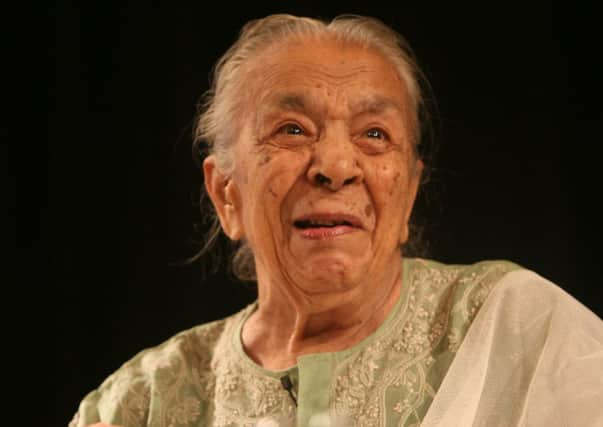Obituary: Zohra Sehgal, actress.


Zohra Sehgal was born into a rich, aristocratic Muslim family in India before the First World War and she survived the turmoil and violence of partition and the heartache of a husband’s suicide before making a successful career in movies in England at an age when most people are enjoying their retirement.
Back in the late 1920s she had an uncle in Edinburgh, who arranged for her to come to Scotland to further her acting ambitions – after she abandoned plans to become a pilot. However, a tortuous overland journey ended in Dresden, where she initially trained as a dancer.
Advertisement
Hide AdAdvertisement
Hide AdIt would be several years before she resumed her pursuit of an acting career, several decades before she finally made it to the UK, and she was in her 70s before she really made her mark on mainstream British audiences, as Lady Chatterjee in ITV’s The Jewel in the Crown.
Frequently Sehgal played elderly immigrants who have been uprooted from their South Asian communities and struggle to cope both with British culture and the modern world.
She was one of the little party from a Birmingham women’s centre who go on an outing to Blackpool in Bhaji on the Beach and she played grandmothers in the ground-breaking Channel 4 comedy series Tandoori Nights and Bend It Like Beckham, the film that made Keira Knightley a star.
Her characters may have been elderly, and she herself was a diminutive figure, but there was often a feisty quality to them.
One of seven children, she was born Sahibzadi Zohra Begum Mumtazullah Khan in Saharanpur, in northern India in 1912. Her mother died when she was very young and she was educated in Lahore at an exclusive girls’ boarding school, with British teachers.
She would later recall that she was always a rebel, beginning in her school days. Later she married a Hindu, became an atheist and as recently as last year told an interviewer that what she had enjoyed most in life was “sex, sex and more sex”.
She had a capacity for mischief undiminished by age and wrong-footed an interviewer from The Hindu newspaper by asking if she was a boy or a girl.
Her father was horrified when it was suggested she might become a pilot. Acting was agreed upon as a compromise between flying and getting married, something she was set against, at least at that juncture. Arrangements were put in place for a long overland trip to Edinburgh, but it ended prematurely when she enrolled in ballet school in Dresden.
Advertisement
Hide AdAdvertisement
Hide AdShe lodged with a local countess and committed the sort of acts that would see her stoned in some Muslim communities. Burqas were cut up to make blouses and petticoats, and by the end of her third year she was in a bikini.
She joined a dance company run by Uday Shankar (Ravi’s brother) and toured Europe, Asia, North America and North Africa.
In 1942 she married Kameshwar Sehgal, an artist. The future Indian Prime Minister Jawaharlal Nehru was expected at the wedding, but he was arrested the previous day and never made it.
She and her husband founded a cultural centre in Lahore and did their best to promote harmony between Muslims and Hindus, but growing tensions in the area forced them to relocate to Bombay (Mumbai), where she became part of the city’s intellectual set and joined the Indian People’s Theatre Association .
She appeared in a few films, including Neecha Nagar (The Lowly City), which won the predecessor award of the Palme d’Or at the first Cannes Film Festival in 1946. But she worked mainly in theatre.
Reconciled to the fact that she was “short, plump and ordinary”, Shegal concluded she would never make a leading lady and had better concentrate on character parts.
In 1959 she was devastated by her husband’s suicide. “I felt that life had come to a halt, but the responsibility of bringing up Kiran and Pavan gave me the strength to move on,” she said in an interview with The Times of India in 2003.
In 1962 she and her two young children came to England when she secured a drama scholarship. She worked at the Old Vic as a dresser, did some tailoring work and got the odd little role in theatre and television, appearing in the BBC’s The Indian Tales of Rudyard Kipling and Doctor Who.
Advertisement
Hide AdAdvertisement
Hide AdWithin a few years she was beginning to get parts in films too, including The Long Duel, with Yul Brynner, The Vengeance of She and The Guru, with Michael York as an unlikely pop star seeking enlightenment in India.
She also featured in Padosi (Neighbours), a 1976-77 BBC serial aimed at immigrants, and played an old prostitute looking back on her life in Ismail Merchant’s 1983 film The Courtesans of Bombay.
But it was The Jewel in the Crown, a lavish adaptation of Paul Scott’s books set in India at the time of the Raj, that really marked Sehgal’s breakthrough. Her name was sometimes spelled Segal on credits, like the American actor.
In her 80s she returned to India, recovered from cancer, was celebrated as “the grand old lady” of Indian cinema and was showered with honours. She continued acting well into her 90s. She is survived by two children, Kiran, a famous Indian classical dancer, and Pavan, who works with the World Health Organisation.
BRIAN PENDREIGH